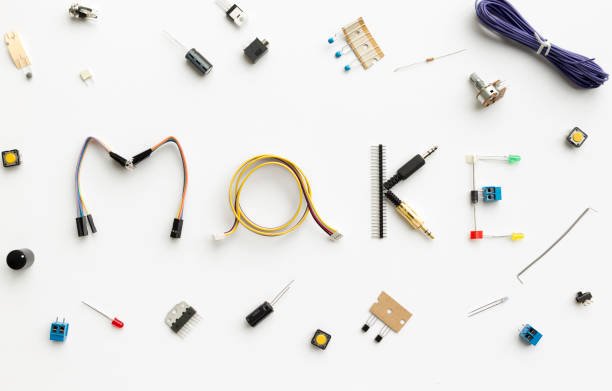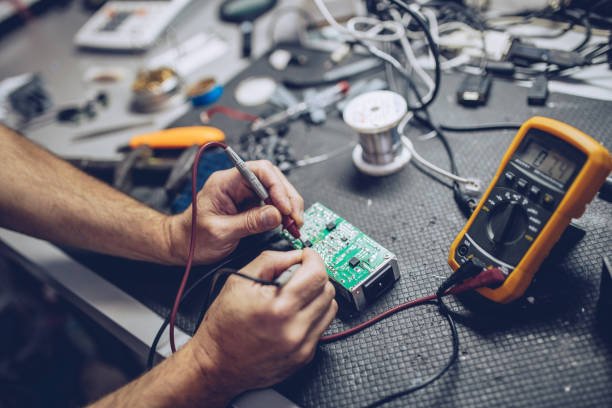Introduction
Are you passionate about electronics? Do you enjoy tinkering with circuits and building your own devices? If so, you’re not alone! DIY electronics projects have gained immense popularity among tech enthusiasts and hobbyists worldwide. Whether you’re a beginner or an experienced maker, diving into the world of do-it-yourself electronics can be an incredibly rewarding and educational experience. In this blog post, we’ll explore the exciting realm of DIY electronics projects, highlighting the importance of step-by-step guides and tutorials to help you embark on your own electronic adventures.

Poster for DIY electronic maker, open-source hardware and software project with breadboard, electronic module, robotic coding , top view of a light background
- The Joy of DIY Electronics
One of the main reasons DIY electronics projects have captured the imagination of many is the sheer joy they bring. Building your own electronic devices, gadgets, and circuits can provide a unique sense of accomplishment and creativity. It allows you to unleash your imagination and transform your ideas into tangible, functional creations. From simple LED circuits to complex home automation systems, the possibilities are endless.
- Step-by-Step Guides: The Building Blocks
Step-by-step guides serve as the building blocks of any successful DIY electronics project. They provide a roadmap that helps you navigate through the complexities of electronic components, circuitry, and programming. A well-structured guide breaks down the project into manageable steps, making it accessible even for beginners. These guides typically include:
a. Materials and Tools: An overview of the necessary components, tools, and equipment required for the project. This ensures you have everything you need before starting.
b. Circuit Diagrams: Visual representations of the circuit connections and component placements. Circuit diagrams help you understand how various parts interact and allow you to troubleshoot potential issues.
c. Assembly Instructions: Detailed instructions on assembling the components, soldering connections, and organizing the circuit layout. Clear explanations and accompanying images or videos enhance comprehension and ease the construction process.
d. Programming and Code: If your project involves microcontrollers or programmable devices, step-by-step guides often provide example code or programming instructions. This enables you to bring your electronics to life and add functionality to your creation.
- Popular DIY Electronics Projects
Let’s explore a few popular DIY electronics projects that have captivated makers worldwide:
a. Arduino-based Home Automation: With an Arduino microcontroller at the heart of your project, you can create a smart home automation system. This might involve controlling lights, appliances, or even setting up voice-activated commands using platforms like Amazon Alexa or Google Assistant.
b. Raspberry Pi Retro Gaming Console: Transform your Raspberry Pi into a retro gaming console, allowing you to play classic video games from various consoles and platforms. By following step-by-step instructions, you can build your own arcade-style gaming experience.
c. LED Cube: An LED cube is a mesmerizing three-dimensional display made up of multiple LEDs. Step-by-step guides will help you understand the wiring and programming required to create different light patterns and animations.
- Learning and Exploring Through DIY Projects
Engaging in DIY electronics projects offers valuable learning opportunities. By following step-by-step guides and tutorials, you gain hands-on experience with electronic components, circuit design, programming, and problem-solving. These skills can lead to a deeper understanding of electronics, fostering creativity and encouraging further exploration in the field.

Engineer or technician repair electronic circuit board with soldering iron
Conclusion
Embarking on DIY electronics projects is an exciting journey that combines creativity, problem-solving, and learning. With the help of step-by-step guides and tutorials, you can bring your ideas to life, explore new technologies, and build functional devices from scratch. Whether you’re interested in home automation, gaming consoles, or eye-catching LED displays, the world of DIY electronics is brimming with possibilities. So gather your components, follow the guides, and immerse yourself in the electrifying realm of do-it-yourself electronics.
FOR MORE TIPS/QUESTIONS, CONTACT US NOW